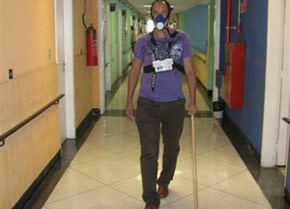

The walking aid reduces pain by approximately 30%, lowers the consumption of anti-inflammatory drugs and increases functional capacity by 20%, according to a new study
The walking aid reduces pain by approximately 30%, lowers the consumption of anti-inflammatory drugs and increases functional capacity by 20%, according to a new study
The walking aid reduces pain by approximately 30%, lowers the consumption of anti-inflammatory drugs and increases functional capacity by 20%, according to a new study

The walking aid reduces pain by approximately 30%, lowers the consumption of anti-inflammatory drugs and increases functional capacity by 20%, according to a new study
By Karina Toledo
Agência FAPESP – A study conducted by Universidade Federal de São Paulo (Unifesp) has shown that the use of a walking cane by patients with knee osteoarthritis helps to reduce pain and the consumption of anti-inflammatory drugs, in addition to improving movement.
The recommendation is part of the guidelines offered by the world’s leading medical societies. Although there are reports of the use of walking canes since antiquity, no study had previously determined whether the practice was truly beneficial.
“Any medical intervention, whether for diagnosis or treatment, should be based on scientific evidence. For this reason, we modeled the study on the highest scientific standards. It was conducted with controlled and randomized trials and an efficacy rater,” explains Dr. Jamil Natour, the coordinator of the FAPESP-funded study.
The results of the study, which included 64 patients, were published in the Annals of the Rheumatic Diseases, one of the most important journals in the field of rheumatology, with this study earning a mention in the editorial.
Arthrosis is a disease caused by the degeneration of the cartilage that covers joints. The level of pain and the functional impact vary according to affected region and the degree to which the cartilage is compromised.
“When it affects the knee, arthrosis can be very debilitating. The patient feels a lot of pain and loses their autonomy. It has a major impact on quality of life,” says Natour.
Milder cases are treated with analgesic medication and exercise to strengthen the muscles of the limb. Worse cases can require surgery to install prostheses.
A cane is recommended to reduce the pressure on the joint. “Part of the effort [required for walking] is shifted to the upper limbs. And the correct way to use a cane is always on the side opposite of the affected knee,” says Natour.
Doctors, however, are worried about the increased energy expenditure from walking with a cane. “With elderly individuals who have cardiac or respiratory problems, for example, this is a consideration,” he affirmed.
However, the study showed that after a period of adaptation, the energy expenditures for walking with and without a cane were equal. “The patient must use the accessory for at least a month to feel the benefits,” says Natour.
Walking test
In the study, the volunteers were split into two groups and underwent evaluations to gauge the level of pain and functional capacity. A 6-minute walking test with and without the cane was used to determine the energy expenditures. During these tests, the patients wore a mask that analyzes the exchange of respiratory gases.
Half of the patients received a wooden cane to take home and were instructed to use it for two months. The other half, the control group, were given the same treatment but did not receive a cane. All patients were reevaluated after 30 and 60 days.
At the end of the study period, the level of pain was reduced by 20% to 30% in the group that received the cane, and the consumption of medication for pain was lower than that in the control group. There was also a 20% improvement in the functional capacity of the group receiving the intervention.
“In the test conducted after 30 days, the energy expenditure while walking with a cane was equal to that while walking without the accessory. In the control group, the patients still spent more energy walking with the cane,” said Natour.
The results could serve as the basis for the inclusion of a cane in the treatments offered by Brazil’s Public Health System (SUS), affirms the researcher.
These results could also help doctors convince patients to use a cane. “Many resisted using the cane because the image is associated with old age and disability. Now, we can show the benefits objectively,” he said.
The article, “Impact of cane use on pain, function, general health and energy expenditure during gait in patients with knee osteoarthritis: a randomised controlled trial” (doi:10.1136/ard.2010.140178) can be read at http://ard.bmj.com/content/71/2/172.full?sid=b8efe0d0-0b72-42b7-bcf4-0a6752701bbb.
Republish
The Agency FAPESP licenses news via Creative Commons (CC-BY-NC-ND) so that they can be republished free of charge and in a simple way by other digital or printed vehicles. Agência FAPESP must be credited as the source of the content being republished and the name of the reporter (if any) must be attributed. Using the HMTL button below allows compliance with these rules, detailed in Digital Republishing Policy FAPESP.





